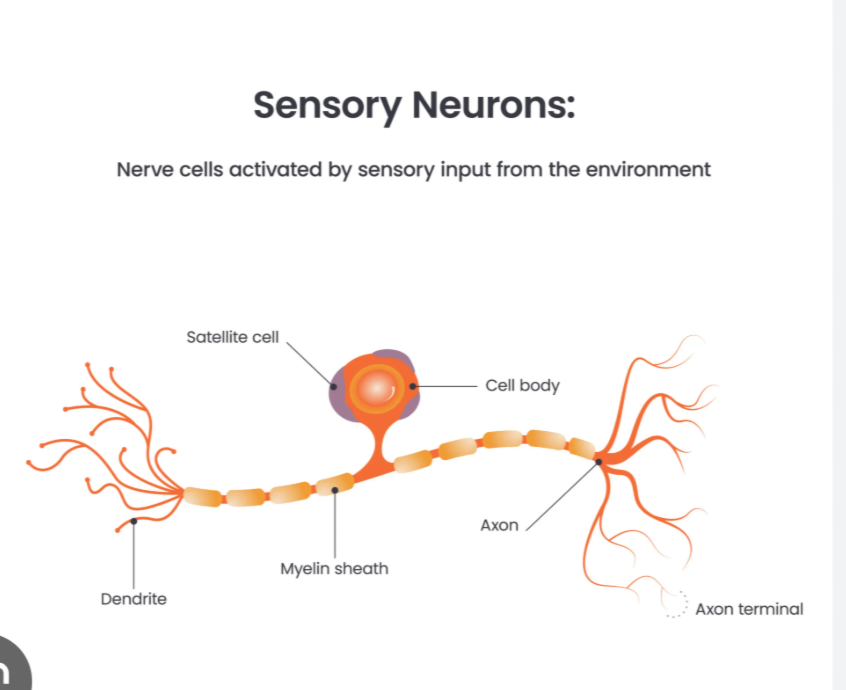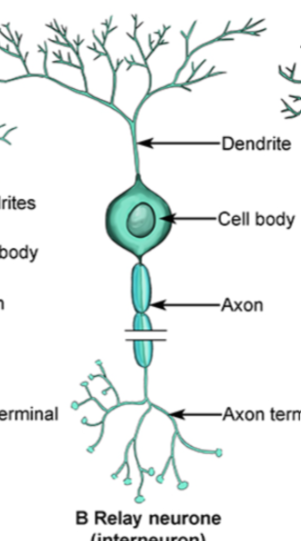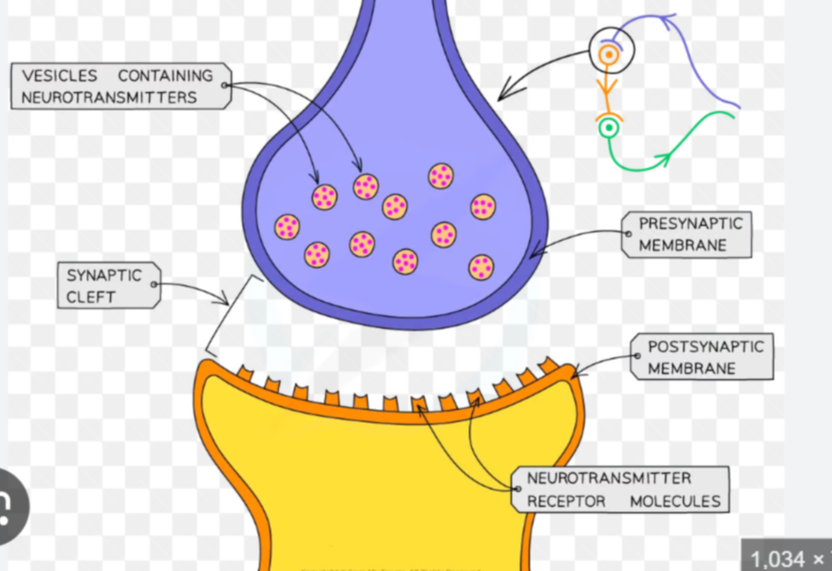year 1 biopsych:
1/94
There's no tags or description
Looks like no tags are added yet.
Name | Mastery | Learn | Test | Matching | Spaced |
|---|
No study sessions yet.
95 Terms
what is the human nervous system?
a complex network of nerve cells that carry messages to and from the brain and spinal chord to different parts of the body and helps different parts of the body communicate with each other
what are the divisions of the nervous system?
cns and peripheral nervous systrem
what is in the CNS?
spinal chord
brain
what is the peripheral nervous system divided into?
somatic
autonomic
what is the autonomic nervous system?
sympathetic
parasympathetic
what is the autonomic nervous system?
brain’s involuntary activities and is self-regulating
what is the somatic nervous system?
part of PNS responsible for carrying sensory and motor information to from the CNS
what are the CNS 2 main function?
control of behaviour
regulation of body’s physiological processes
what are the functions of the spinal chord?
rely info between brain and body → allows brain to monitor and regulate bodily process such as breathing + coordinate voluntary movements
connected to different parts of the body by spinal nerves which connect to muscles and glands
contains nerve cells which enable us to perform reflexes
what are the 4 main areas of the brain?
cerebrum
cerebellum
diencephalon
brain stem
what is the cerebrum?
largest part of brain divided into TOPF
split down the middle into cerebral hemispheres which communicate through corpus callosum
responsible for conscious thought, memory, reasoning, intelligence, and voluntary movement
what is cerebellum?
sits beneath cerebrum
involved in controlling motor skills and balance, coordinating muscles to enable precise movements
abnormalities can result in problems such as epilepsy
what is the diencephalon?
two important structures - thalamus and hypothalamus
what does thalamus do?
relay station for nerve impulses coming from senses - routes them to part of the brain where they can be processes
what does the hypothalamus do?
regulates body temp, hunger and thirst
acts as link between endocrine system and nervous system
controls release of hormones from pituatry
what does the brain stem do?
regulates automatic functions essential for life such as breathing, heartbeat and swallowing
motor and sensory neurons pass through, allowing impulses to pass between brain and spinal chord
What is the function of the somatic nervous system?
Controls voluntary responses
- Transmits sensory info from the sense receptors to the CNS (connects the CNS + the senses) -> to + from CNS
- Control skeletal muscles
- Enables reflex actions
- Transmits info from brain to muscles to produce muscle movement
What does the somatic nervous system consist of?
Sensory receptors and motor pathways
What do sensory receptors do?
Carry information to the spinal cord + brain
What do motor pathways do?
Allow the brain to control movement
What is homeostasis?
Maintaining a stable internal environment (e.g bodily temperature, heart rate, blood pressure)
What is the autonomic nervous system composed of?
motor pathways
What word describes the way in which the sympathetic and the parasympathetic nervous systems work?
Antagonistic (work in opposition to each other)
What is the role of the sympathetic nervous system?
starts fight or flight
- Increases heart rate
- Slows digestion
- Dilates pupils
what is the role of the parasympathetic nervous system?
Stops fight or flight -> returns to peaceful state; conserved energy; provided rest + digest functions
- Decreases heart rate
- Increases digestion
- Constricts pupils
What are the 3 types of neurons?
motor, relay and sensory
what does a sensory neuron look like?

what does a sensory neuron do?
Carries electrical impulses from sensory receptors towards the brain and spinal cord
where are they found?
in sensory receptors
How do sensory neurons transfer impulses to the CNS?
Via the PNS
what does a motor neuron look like?

what does a motor neuron do?
Carries nerve impulses from the CNS (brain/spinal cord) to muscles/glands (effector organs)
what do motor neurons form synapses with?
muscles and control their contractions
Where do you find motor neurons?
In the spinal cord and the brain
How do motors neurons transfer impulses to effectors?
via long axons
what does a relay neuron look like?

What does a relay neuron do?
Carries nerve impulses between neurons; involved in analysis of sensation + decide on best response
where is a relay neuron found?
only CNS
How do muscle contractions occur?
- When stimulated, the motor neuron releases neurotransmitters that bind to receptors on muscles -> trigger a response which leads to muscle movement
- The axon of a motor neuron fires -> muscle with which it has formed synapses with contracts
what does strength of contraction depend on?
The rate of firing of the axons of motor neurons that control it
how is muscle relaxation caused?
inhibition of motor neuron
What are the main features of a neuron?
- Dendrites
- Myelin Sheath
- Axon
- Axon terminals
what are the functions of dentrites?
Receive signals from other neurons or from sensory receptor cells (typically connected to cell body)
what is the function of a myelin sheath?
Insulates the axon so that the electrical impulses travel faster along the axon
what is axon’s function?
Long slender fibre that carries nerve impulses, in the form of an electrical signal (action potential)
what is function of an axon terminal?
Connects the neuron to other neurons (or directly to organs) using a process called synaptic transmission
Why can neurons only transmit information in one direction at a synapse?
- Synaptic vesicles are only released from the presynaptic membrane
- Receptors are only present on the postsynaptic membrane -> it is the binding of the neurotransmitter to the receptor which enables the signal to be passed on
- The neurotransmitters diffuse across the gap -> can only go from high to low concentration -> can only go from presynaptic to the postsynaptic membrane
What happens when a neurotransmitter crosses a synaptic gap?
It can either have an excitatory or inhibitory effect on the postsynaptic neuron
what does a synapse look like?

When does excitation occur?
When receptor stimulation results in an increase in the positive charge of the postsynaptic neuron -> increases likelihood of the neuron firing and passing on the electrical impulse
Excitatory postsynaptic potential (EPSP)
When does inhibition occur?
When receptor stimulation results in an increase in the negative charge of the postsynaptic neuron -> decreases likelihood of the neuron firing and passing on the electrical impulse
Inhibitory post synaptic potential (IPSP)
what is summation?
Addition of positive and negative postsynaptic potentials
What is synaptic transmission?
The process of sending information from one neuron to another; impulse crosses a synapse
What is a synapse also known as?
synaptic cleft
How is information passed down the axon of the neuron?
Electrical impulse - action potential
What happens when the electrical signal reaches the axon terminal?
- Electrical impulse is converted into a chemical which triggers the release of the neurotransmitter from vesicles (on pre-synaptic membrane) + cross over the synapse
- They bind to receptors sites (on postsynaptic membrane) in the dendrites of the other neurons
What happens when a neurotransmitter is taken up by the receptor of the next neuron?
It is converted back to an electrical signal -> passes along the axon of that neuron until it reaches the next axon terminal
What is the endocrine system?
A network of glands that manufacture + secrete hormones
what is the role of the endocrine system?
Secretes hormones that are required to regulate many bodily functions (e.g release of a required amount of a specific hormone to promote appropriate growth); provides a chemical system of communication via the bloodstream
what other system does the endocrine system support?
The nervous system
what are hormones?
Chemical signals secreted by the endocrine glands into the circulatory system via the blood which convey regulatory messages within the body
can hormones effect any cell?
No -> only target cells as there has to be particular receptors for particular hormones (cells without these receptors can't be influenced directly by these hormones)
What does (negative) feedback ensure?
A stable concentration of hormones
where does hypothalamus send signal to?
pituitary
How does secretion start and shut down?
Hypothalamus sends signals to pituitary gland -> secretes stimulating hormone -> signals target gland to secrete hormone -> hormone rises in bloodstream -> hypothalamus shuts down secretion of hormone -> pituitary gland shuts down stimulatory hormone -> slows secretion of target gland hormones -> STABLE CONCENTRATION
What is the function of pituitary gland?
- Produces hormones whose primary function is to influence the release of hormones from other glands -> regulate many of the body's function
what are two lobes of pituarty?
anterior
posterior
what hormones does anterior produce?
- ACTH -> used as a response to stress -> produces cortisol
- LH + FSH -> stimulate the ovaries to produce oestrogen + progesterone or in testes to produce testosterone + sperm
What hormone does the posterior produce?
Oxytocin -> stimulates the contraction of the uterus in childbirth + is important for mother-infant bonding
what is function of adrenal gland?
Facilitates the releases of adrenaline (which controls fight or flight response)
what are parts of adrenal gland?
outer - cortex
inner - medulla
what does cortex produce?
Cortisol -> cardiovascular + anti-inflammatory functions
What hormones do the adrenal medulla produce?
- Adrenaline -> helps body respond to stressful situations (e.g increasing heart rate + blood flow to muscles/brain)
- Noradrenaline -> constricts blood vessels -> blood pressure increases + helps us focus on fight or flight
What is the function of the testes?
Facilitate the release of testosterone (male hormone)
What is the role of the hypothalamus and pituitary in testosterone production?
H - instructs the pituitary gland on how much testosterone to produce
P - Passes on instruction from the hypothalamus to the testes
What is the function of the ovaries?
Facilitate the release of oestrogen and progesterone (female hormones)
What is the function of oestrogen?
- Controls puberty
- Strengthens bones
- Causes growth and repair of the lining of the uterus wall
What is the function of progesterone?
- Important in post-ovulation phase of the menstrual cycle
- Maintains the uterus lining
What is the role of adrenaline?
- Released by adrenal medulla in response to the SNS
- Increases blood flow to brain + (skeletal) muscles
- Diverts blood away from skin, kidneys + digestive system
- Increased respiration + sweating
- Increases blood supply/oxygen to muscles for physical action
liver releases glucose
increased breathing and heart rate
pupils dilate
What does fight or flight enable animals and humans to do?
evolved as survival mechanism
React quickly to life threatening situations -> allow individual to fight off the threat or flee to safety
What area of the brain is mobilised when a person is faced with a threat?
amygdala
What does the amygdala do?
- Associates sensory signals with emotions associated with fight or flight (e.g fear or anger)
- Sends a distress signal to the hypothalamus (communicates with the SNS)
what are two types of stressors?
Acute (sudden), chronic (ongoing
What are the major systems for dealing with stress?
HPA - long term
SAM - acute
What is the role of the sympathetic nervous system in the response to acute stressors?
- Is triggered + begins preparing the body for the rapid action necessary for fight or flight
- SNS send signal through to the adrenal medulla -> responds by releasing adrenaline into the bloodstream
What are examples of physiological changes adrenaline causes?
- Heart beats faster -> pushes blood to muscles + heart + blood pressure increases
- Breathing becomes more rapid in order to take in more oxygen
- Triggers release of blood sugar + fats in the bloodstream -> energy for fight or flight response
what is role of parasympathetic nervous system?
- Dampens down the stress response
- Slows down heart rate
- Reduces blood pressure
- Digestion begins again (was inhibited when SNS is aroused)
What is the role of the hypothalamus in the response to chronic stressors?
Releases CRH (chemical messenger) into the bloodstream
What is the role of the pituitary gland in response to chronic stressors?
CRH causes it to produce + release ACTH into the bloodstream to its target site in the adrenal glands
What is the role of the adrenal glands in response to chronic stressors?
- ACTH stimulates the adrenal cortex to release stress-related hormones (e.g cortisol)
What does cortisol do?
- Gives a burst of energy
- Lowers sensitivity to pain
- Impaired cognitive performance
- Lowered immune response
What do the hypothalamus and pituitary gland have?
Receptors that monitor circulating cortisol levels
What happens when cortisol levels rise?
Receptors initiate a reduction in CRH + ACTH levels -> brings cortisol levels back to normal
What are weaknesses of biopsychology/the fight-or-flight response?
- It's not the first phase of the reaction to stress -> Gray (1988) said that the freeze response at first to avoid confrontation (animal is hyper vigilant + alert to the slightest signs of danger) -> focuses attention + animals look for new info to make the best response to that threat
- Negative consequences -> physiological responses are adapted for a response that requires energetic behaviour not the stresses of modern life (less physically demanding) -> repeated activation can lead to damaged blood vessels, heart disease and a supressed immune system due to cortisol (which assists the body in fighting infection only in smaller amounts) -> increases stress related illnesses
Why do some people believe that females respond to stress differently to males?
- Taylor et al (2000) said women's behavioural responses were more characterised by 'tend and befriend' -> involves protecting themselves + their offspring + forming protective alliances with other women -> their response evolved in the context of being the primary caregiver (fleeing puts offspring at risk) -> explained by levels of oxytocin in females + suggests previous research (mainly done on males) has obscured patterns of stress response in females
- Lee + Harley (2012) found SRY gene found exclusively in Y chromosome in males -> promotes aggression + results in fight or flight response -> may prime males to respond by releasing stress hormones (e.g adrenaline) + increasing blood flow to organs involved in fight or flight -> women don't have this gene which may prevent them from responding in this way